Cemeteries
Among the thousands of burials at Union Cemetery, there are 275 veterans who served our country. 20 of these veterans died while in service and are considered Gold Star Veterans.
The goal of this page is to record the life and death of these veterans who died in service–making them real people and not just a name on a tombstone.
The biographies have been researched and written by Crystal Lake resident, Nathalie Holberg. If anyone has additional information, photos, etc. on the veterans, please contact the Society at: info@cl-hs.org

Charles Edwin Behan
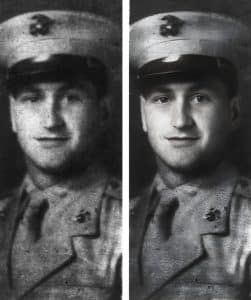
Once an all-star athlete, First Lieutenant Charles E. Behan distinguished himself in one the most brutal confrontations during the Battle of Okinawa. Born on August 4, 1920, to Louise and Charles Behan, he was the second of three children. He grew up with his older sister Victoria and younger brother Paul. The family lived in a house near the Fox River, and he attended grade school at St. Thomas Catholic School. He was so well-liked that he had at least three different nicknames, including Charlie, Ed, and Buddy.
Charles lived and breathed sports. At Crystal Lake Community High School, he excelled in basketball and track. He then majored in physical education and industrial arts at the Northern Illinois State Teachers College at DeKalb (now NIU). There, he won the heavyweight boxing title and lettered in both football and track. Charles even placed ninth in the 1942 National A.A.U. Decathlon; he took home first place in the javelin and placed in several other events as well. A lot of newspaper ink was used to celebrate his athletic accomplishments.
In the summer after he graduated from college, Charles tried out for the Detroit Lions—and made the team. He played the 1942 season as a rookie end, which in 1940s football combined the responsibilities of a modern wide receiver and tight end. He caught four passes for 63 yards during his one and only season.
His path soon veered from stadiums to military service. On January 12, 1943, he joined the U.S. Marines and started boot camp. His brother Paul joined the Navy soon after. Once Charles completed officer training at Quantico, he was commissioned as a second lieutenant in July 1943 and assigned to the 6th Marine Division. He fought at the Battle of Guadalcanal in the South Pacific.
By December 1944, Charles was still stationed on Guadalcanal. To boost morale, he helped organize and lead the now-legendary “Mosquito Bowl,” a fiercely contested Christmas Eve football game between the 29th and 4th Marine Regiments. Behan was the 29th Marines’ player-coach and end, facing off against other collegiate and professional athletes. Although the game was officially “touch” football, players encountered hard hits and bloodied knees. The match ended in a scoreless tie in front of a crowd of thousands of cheering servicemembers.
In April 1945, Charles’s unit joined the Battle of Okinawa. A month later, they were ordered to take Sugar Loaf Hill, a small but heavily fortified Japanese stronghold that ultimately took 11 assaults to capture. On May 18, 1945, Charles was wounded by shrapnel in the mouth. Refusing to leave his unit, he packed the wound with cotton and pressed onward. Unable to speak, he directed his men with hand signals, repeatedly exposing himself to enemy fire. After he was hit again and mortally wounded, he pulled himself behind a rock and continued giving instructions until he lost consciousness. He was 24 years old.
Charles was posthumously awarded the Navy Cross and Bronze Star for his extraordinary actions. His Navy Cross citation commends his “staunch leadership, extreme fortitude and perseverance in the face of overwhelming odds.” His remains were returned to Crystal Lake in March 1949. His brother had made it home from the war safely. The family held a funeral service in early April, and Charles was buried with full military honors at Union Cemetery. Today, his parents are buried beside him.
Ernest W. Blank
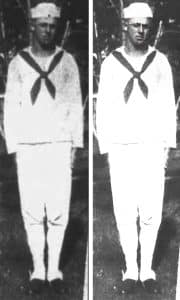
Ernest William Blank was born on April 19, 1898, in Crystal Lake to Herman and Augusta Blank. He was the youngest of six children. Ernest is remembered not only for his service, but also for the warmth of his character and the great affection of those who knew him.
Growing up, he attended Immanuel Lutheran School, and he enjoyed fishing at Slocum Lake and the Fox River with family and friends. He worked at the North Crystal Lake Post Office and later, the Public Service Company, which was a division of ComEd. Ernest remained there for nearly three years before enlisting in the U.S. Navy at the age of twenty. He left in August 1918 for the Great Lakes Naval Training Station near North Chicago, where he served as an apprentice seaman.
However, mere weeks into his service, Ernest contracted Spanish influenza during the deadly 1918 pandemic that swept through military and civilian communities alike. He died on September 28, 1918, before his family could reach him.
His funeral, held at Immanuel Lutheran Church, was one of the largest the town had seen. For the first time, a fallen soldier’s body had been returned home for burial before the war ended. The service featured hymns from the church and school choirs, and his school friends served as pallbearers and flower bearers. Fourteen members of the Elgin National Guard honored him with a regulation military salute at Union Cemetery, followed by a haunting echo of taps played by two buglers.
Two servicemen who trained with Ernest wrote to his family after his death, saying they had “grown to know and love him as a brother, to admire his qualities as a gentleman, and to hold him as a man worthy of the uniform of the United States Navy.”
A Victory Bell was dedicated in September 1919 at the St. Mary Catholic Church in McHenry. Inscribed on the bronze bell were Ernest’s name and those of all the McHenry County servicemen who gave their lives during World War I.
Herbert Willoughby Booth, Jr.

Captain Herbert Willoughby Booth, Jr., known simply as “Bill” to friends and family, was born on October 19, 1930, in Sarasota, Florida. His roots stretched back to Crystal Lake, where his grandparents settled down in 1909. His father, Herbert Sr., a veteran of the U.S. Army Air Corps during World War II, passed on both a legacy of service and a deep respect for aviation that would shape Bill’s life.
Bill graduated from Sarasota High School in 1948 with one goal: to become a pilot. Determined to pursue a career in the Air Force, he set his sights on the U.S. Military Academy at West Point. However, admission required a nomination from a member of Congress or the Vice President, and the process was intensely competitive. While waiting for his appointment, Bill attended the Virginia Military Institute for two years, where he was on the wrestling team and sang in the glee club. He was accepted to West Point in 1950 and graduated in 1954 with a commission into the U.S. Air Force. One classmate said of Bill, “Bill was highly disciplined, with excellent military bearing. We all knew he would be an outstanding leader.”
In August 1955, Bill married Nancy Penrose, an elementary school teacher. Friends and family came from around the country to celebrate their wedding; his father stood by his side as best man. The couple spent their early years together stationed at Webb Air Force Base in Texas. By the early 1960s, they had started a family, and Bill was training at Hurlburt Field in Florida for a new assignment overseas.
In the fall of 1962, Bill deployed to Vietnam for a covert operation in the country’s Central Highlands. His son, Herbert Willoughby III, was 19 months old, and his daughter, Victoria, had just been born.
Bill was assigned to Detachment 2A of the 4400th Combat Crew Training Squadron and served as a Forward Air Controller (FAC). His mission was part of the Buôn Enao Project, which would later expand into the larger Civilian Irregular Defense Group, run by U.S. Special Forces. As a FAC, Bill flew dangerous low-level missions to direct air strikes, conduct reconnaissance, and support rescue efforts.
On the evening of October 15, 1962, just four days before his 32nd birthday, Bill took off in a Helio U-10 “Super Courier” aircraft (call sign Dora Corn) for a mission over Darlac Province. He was joined by Captain Terry Cordell and Technical Sergeant Richard L. Foxx. They were conducting aerial reconnaissance and coordinating a strike on a Viet Cong training camp when they were hit by ground fire. The aircraft caught fire and crashed in the dense jungle. All three men were killed.
After his remains were returned to his family, Bill was cremated, and his ashes were scattered over the Gulf of Mexico and Myakka River State Park in Sarasota. A memorial marker was placed at Union Cemetery in Crystal Lake, not far from where his grandparents are buried. His name is also engraved on the Vietnam Veterans Memorial in Washington, D.C., on Panel 1E, Line 13. For his actions in Vietnam, he was posthumously awarded the Distinguished Flying Cross.
Following Bill’s death, Nancy remained in Florida to raise their children. Though his life was cut short, his legacy endures. A memorial tribute from his West Point class summed it up best:
“Yes, Bill, your dry wit entertained us. Your ideals and career inspired us. Your life goes on in the hearts and minds of your classmates and your family. We all sure miss you.”
John H. Clarke

First Sergeant John H. Clarke was a dedicated serviceman, remembered for his honesty and friendliness. Born on April 1, 1908, to Thomas and Emma Dehne Clarke, he grew up here in Crystal Lake with three sisters. On October 21, 1936, John married Lillian Handrock in a small ceremony.
Before his military service, he worked for the American Terra Cotta Company, Overton Motor Service, and the Yellow Cab Company. He also served the Crystal Lake community as a firefighter. John joined the National Guard in 1933, setting him on a path of committed military service.
When his unit was mobilized in 1941 during World War II, he began rigorous training at several U.S. military installations, eventually leading him and Lillian to Camp Carson in Colorado Springs, where he trained other soldiers.
Over 30 years old, John was concerned he wouldn’t be allowed to fight overseas because the military wanted younger men on the frontline. However, he insisted on being involved in the actual fighting and was sent to Europe in 1943. On June 6, 1944, he was part of the Allied Invasion of Normandy (also known as “D-Day”), which was crucial to the liberation of France and turning the tide in the war against the Nazis.
Tragically, John was killed on June 8, 1944, on the beaches of Normandy, in an explosion believed to have been caused by a landmine. He was posthumously awarded the Purple Heart for his service and sacrifice.
First Sergeant Clarke’s funeral in 1947 was a moving ceremony that drew a vast number of mourners. Local organizations, including the American Legion, Veterans of Foreign Wars, and the Crystal Lake Fire Department, honored him, and a firing squad marked his burial with a final salute. He was survived by his wife Lillian, who later remarried, and two sisters, Ella Ketelson and Mildred Clarke, along with a niece and three nephews.
After John’s death, Lillian published the following memorial in the Crystal Lake Herald:
“In cherished memory of my husband, First Sgt. John Clarke, who gave his life on June 8, 1944, on the battlefields of France. The guns are silent there now only because fine young soldiers fought for the ideals of liberty, some, like him, making even the supreme sacrifice.”
Paul Earl Colby
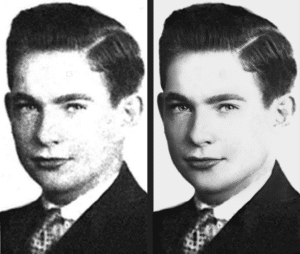
Born on November 10, 1923, Technical Sergeant Paul Earl Colby was the youngest child of Earl and Hazel Colby. He had two brothers, Lester and LaVerne, and one sister, Dorothy. The family lived on Woodstock Street in Crystal Lake.
Paul attended Crystal Lake Community High School, where he enjoyed playing tennis. After graduating in 1941, Paul worked for the National Grain Yeast Corporation. He was drafted into the U.S. Army Air Corps on January 10, 1943. His training took him to military bases across the country, including in Oklahoma, Kansas, and Texas.
Paul and his brother LaVerne attended radio school together in Sioux Falls, South Dakota, where they learned Morse code, radio operations, and in-flight communications. They graduated in March 1944. After radio school, Paul moved on to Yuma, Arizona, for gunnery training, then returned to Texas for bomber training at Biggs Field.
In August 1944, Paul shipped out to England and joined the 93rd Bombardment Group as a radio gunner in the Eighth Air Force. The 93rd was nicknamed “The Traveling Circus” for its storied service across multiple theaters, which was unusual for a heavy bomber group. By early 1945, the 93rd had completed 300 combat missions.
Paul was promoted to Technical Sergeant in December 1944 and flew high-altitude missions targeting German industrial sites. He also contributed to critical efforts, such as delivering fuel to Allied forces during the Siege of Bastogne. His brothers also fought overseas; LaVerne served as a glider pilot, and Lester was a corporal.
On February 3, 1945, Paul took off on what he believed would be his final mission before returning home. However, during a daylight raid over Benthe, Germany, his plane was shot down by German anti-aircraft fire. When his plane didn’t return that day, he was reported as missing in action; the International Red Cross confirmed his death in March 1945. Both of his brothers survived the war.
Initially buried at the U.S. military cemetery in Neuville-en-Condroz, Belgium, Paul’s remains were returned to Crystal Lake in June 1949. He was laid to rest here in Union Cemetery, and the American Legion provided full military honors at his funeral. LaVerne later named his oldest son Paul.
Clarence A. Ehrke

Private First Class Clarence A. Ehrke was born on August 21, 1920, in Crystal Lake. He was remembered as “a friendly and energetic young man,” and his cheerfulness earned him the nickname of “Happy.” He was the second of six children born to Albert and Alma Ehrke. The Ehrkes were longtime Crystal Lake residents, with roots tracing back to his grandfather Frederick, who emigrated from Germany in 1867.
For the first three years of his life, Clarence lived in the historic Colonel Palmer House with his family. He was a member of the Immanuel Lutheran Church and was confirmed there at the age of 13. Clarence also attended Immanuel Lutheran School, where he served on the school boys’ patrol.
After graduating from the eighth grade in 1934, he decided to enter the workforce full-time. He first worked at the Hinner Rose Farm near Woodstock, then at the American Terra Cotta and Ceramics Company. Before he was drafted, he and his older brother Arthur worked at the Crystal Lake Dairy plant together.
Clarence was inducted into the U.S. Army on December 21, 1942. Over the next year, he trained at half a dozen military bases around the country, including Camp Grant, Camp Beale, and Camp Maxey. He had one last furlough with his family in November 1943 before being sent to England in February 1944. He was assigned to Company C of the 747th Tank Battalion, serving as a specialist in heavy tank operations.
On June 6, 1944, the Allies landed on the beaches of Normandy (also known as “D-Day”) to liberate France as part of Operation Overlord. D-Day was a critical turning point for the Allies during World War II, and Clarence was among the American soldiers who pushed inland from the beaches during the initial days of the campaign. He was killed in action on June 8, 1944, at the age of 23. Another Crystal Lake man, First Sergeant John H. Clarke, died that same day in the invasion.
Clarence was first buried in the La Cambe military cemetery, near Omaha Beach in France. In 1948, his remains were returned to Crystal Lake and reinterred at Union Cemetery with military honors provided by the American Legion and VFW. Two of his brothers, Arthur and Arnold, also served in the Army during World War II and returned home safely. Clarence now rests beside his parents, grandparents, and infant brother, Albert Jr.
Herbert W. Fahrenholz
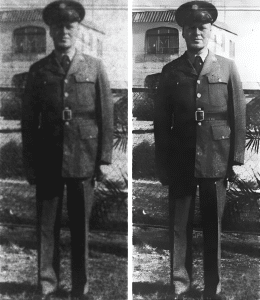
Private First Class Herbert William Fahrenholz was born on August 19, 1908, in Crystal Lake. His parents were John and Caroline Fahrenholz, and he was one of nine children. Herbert lived with his family on Rosedale Avenue. He attended Immanuel Lutheran School and was confirmed at Immanuel Lutheran Church when he was 13.
After completing eighth grade, Herbert left school to hold a variety of jobs, including working as a lineman for an electric company. Later, he joined the American Terra Cotta and Ceramic Company, where his father had also worked. He was a truck driver there and helped out in the assembly fitting room. However, his experience at the company likely soured when an 800-pound piece of terra cotta crushed his finger. He would go on to work for a local contractor named John Green.
Herbert was active in the community and joined Crystal Lake’s first-ever bowling league in 1932. He bowled in the league for many years, including on teams sponsored by Heisler’s Bootery and Althafer’s Drug Store.
On August 17, 1942, Herbert was drafted into the U.S. Army. He was one of nearly 100 men from McHenry County to leave for military service that day. Herbert spent the next two years training at several bases around the country. Eventually, he joined a coastal anti-aircraft battery unit near Los Angeles at Fort MacArthur and was later transferred to the infantry at Camp McCoy in Wisconsin.
Herbert visited his family one last time before heading to England in September 1944. Shortly after his arrival, he was deployed to mainland Europe. Serving with Company H, 406th Infantry Regiment, 102nd “Ozark” Division, Herbert fought in Belgium and Holland as part of the Northern France Campaign. His final letter home spoke of his first combat mission and the kindness of the Dutch.
As part of the larger Rhineland Campaign, Allied forces pushed toward the Roer River in late November. During Operation Queen, Herbert was killed in action on December 2, 1944, near Linnich, Germany. He was 36 years old and had been on the European front for just two months.
A memorial service was held at his home church in January 1945. Over three years later, Herbert’s remains were returned to Crystal Lake and laid to rest at Union Cemetery. The American Legion William Chandler Peterson Post No. 171 saluted him with full military honors. Today, Herbert rests here with his parents and three of his siblings.
Glenn Rixon Farren
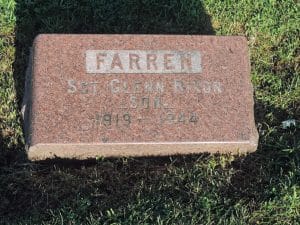 Sergeant Glenn Rixon Farren was born in Chicago on June 9, 1919. He was the only child of Ruth M. (Levin) Farren and Lawrence Farren. Glenn’s parents were estranged for most of his life, but he was doted on by his mother and his grandmother, Ella Levin. Ruth was a schoolteacher, and Ella was the owner of a boarding house in Crystal Lake.
Sergeant Glenn Rixon Farren was born in Chicago on June 9, 1919. He was the only child of Ruth M. (Levin) Farren and Lawrence Farren. Glenn’s parents were estranged for most of his life, but he was doted on by his mother and his grandmother, Ella Levin. Ruth was a schoolteacher, and Ella was the owner of a boarding house in Crystal Lake.
When Glenn was about two years old, the three of them moved from Chicago to Crystal Lake to be closer to family and Ella’s business, the Crystal Lake House. Soon after, Ella decided to sell the boarding house and retire in St. Petersburg, Florida. During the winter, Ruth and Glenn often took road trips to visit Ella in Florida, which had become a popular vacation spot for snow-weary Crystal Lake residents.
Around 1925, Glenn and Ruth joined Ella in St. Petersburg permanently, and they all lived there together for the rest of his childhood. Growing up, Glenn stood out for both his academic strengths and his active role in school. While he attended Lakeview Elementary, he was frequently recognized in the Tampa Bay Times for his perfect spelling. Glenn also performed in school assemblies, played for the school softball team, and served on the Schoolboy Patrol.
Though generally well-behaved, Glenn did have a slight rebellious streak. At 16, he had a brush with the law when he gave a passenger a ride on a single-seat motorcycle. However, the infraction was minor enough that the judge waived the three-dollar fine on the condition Glenn not ride a motorcycle in St. Petersburg for 10 days.
By early adulthood, his interest in motorcycles evolved into an enthusiasm for aviation. He attended the Ryan School of Aeronautics in San Diego, and in 1941, he enlisted in the U.S. Army Air Corps at the age of 21. Glenn served at Moffett Field and the Chico Army Airfield, both in California.
During his military service, Glenn married Georgia Pearl McClure in 1942. However, less than two years later, he became seriously ill with a lung condition and was admitted to Livermore Veterans Hospital. Glenn never recovered, and he passed away on April 6, 1944, at the age of 24.
Ruth and Georgia drove together from California to Crystal Lake for his funeral. Glenn was buried in Union Cemetery, and the American Legion color guard, as well as soldiers from Fort Sheridan, saluted him with full military honors at the graveside ceremony. Today, he and his grandmother rest together here in Union Cemetery.
William M. Fitzgerald
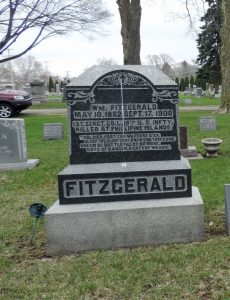 Sergeant William M. Fitzgerald was born in 1862 in County Tipperary, Ireland. He was the eldest of one brother and four sisters. His parents, Daniel and Elizabeth, settled in Crystal Lake with their family in 1885. In August of that same year, William enlisted in the U.S. Army.
Sergeant William M. Fitzgerald was born in 1862 in County Tipperary, Ireland. He was the eldest of one brother and four sisters. His parents, Daniel and Elizabeth, settled in Crystal Lake with their family in 1885. In August of that same year, William enlisted in the U.S. Army.
He served in the military for the next fifteen years, re-enlisting without hesitation at the end of each term— sometimes only a day after being discharged. William was stationed at various installations around the U.S., including in Arizona, Illinois, Missouri, and Montana. He steadily advanced in rank, eventually becoming a sergeant in Company L of the 15th Infantry Regiment.
William fought in the Spanish-American War and was in Ciego de Avila, Cuba, when the conflict ended in December 1898. Once again, he re-enlisted and fought in the Philippine-American War, which was a conflict between the United States and Filipino nationalists that lasted from 1899 to 1902. The war was a result of the United States’ desire to expand its influence in the Pacific.
On September 17, 1900, William was killed in the Battle of Mabitac. His regiment was severely outnumbered, and they faced grueling conditions of flooding waters and waist-deep mud. He was buried here in Union Cemetery in a Catholic ceremony on February 8, 1901. His family honored his service and sacrifice with the following epitaph on his headstone:
“Soldier, rest. Thy warfare o’er.
Sleep the sleep that knows not breaking.
Dream of battlefields no more,
Days of danger, nights of waking.”
After William’s death, his younger brother Michael became a well-known and beloved member of the Crystal Lake community as the Park District Superintendent. In honor of his brother, Michael named his firstborn son William.
Lynn L. Gumprecht
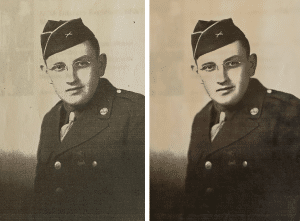
Private Lynn Lavern Gumprecht was born on April 10, 1925, in Crystal Lake. Raised by his parents, Henry and Illa Gumprecht, Lynn was the oldest of four children. He had three sisters: Irma, Jean, and Ruth. As a boy, he enjoyed playing pinochle with his grandfather and was an active member of Bethany Lutheran Church. His sister Irma described him as “a fun-loving guy.” He attended Crystal Lake Community High School and was known for being calm and hardworking.
After graduating from high school in 1943, Lynn worked part-time for his father’s plumbing business, as well as at the Jewel Tea Company, which was the precursor to Jewel-Osco. He spoke of wanting to become a truck driver but was drafted into the U.S. Army that July.
Lynn completed basic training at Camp Grant and received infantry training at Fort McClellan, Alabama, where he earned a Sharpshooter medal in October 1943. Lynn and his family wrote each other letters nearly every day, which he often read by candlelight. The Gumprechts sent Lynn care packages of cookies, gum, cigarettes, and stationery as often as they could. In particular, he treasured an ID bracelet his sister Irma gave him. These bracelets were popular gifts for servicemen during World War II, serving as both a keepsake and a backup form of identification.
In early 1944, Lynn was granted a final furlough at home before heading to Europe. He arrived in Italy on April 2 and was soon sent to the front lines with the 337th Infantry Regiment, 85th Division. On May 12, 1944, while the Allies pushed toward Rome, Lynn was killed by shell fragments. He was 19 years old. Although the military initially reported him as missing, his family didn’t receive official confirmation of his death until nearly a year later. “We hoped he was missing and would be found,” his sister Jean reflected to the Northwest Herald.
Lynn was interred in the Sicily-Rome American Cemetery in Nettuno, Italy, at his parents’ request. On May 29, 1945, a parade in Tai di Cadore honored fallen servicemen from the 337th Infantry Regiment, including Lynn. A stone cenotaph was placed here in Union Cemetery in his memory.
In May 1994, nearly fifty years after Lynn’s death, 45 of his relatives—including his three sisters—gathered at his cenotaph. Ruth’s grandson played taps in honor of his great-uncle. Although Lynn was buried far from home, his family ensured he would not be forgotten in Crystal Lake.
Walter Wellman Pederson
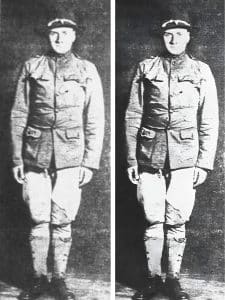
Private Walter Wellman Pederson was born on March 8, 1894, in Laona in Winnebago County. He was the eighth of eleven children born to Ole and Sophronia Pederson. His father was originally from Norway, and his mother was a native of Davis, Illinois. Walter spent most of his early life in Laona, laboring on the family’s farm and later working for his older brother Peter.
Following the death of his father in 1906 and his brother Martin in 1905, Walter moved with his mother and siblings to McHenry in 1910. Around 1915, the family settled in Crystal Lake. He was called to service with the U.S. Army on June 27, 1918. Walter was assigned to Company C, 1st Provisional Battalion, and began training at Camp Grant in Rockford.
Described as “a young man of splendid character,” Walter was known for his genial personality and enjoyed his time and work at the camp. However, in late September 1918, he contracted the Spanish flu. He was transferred to the hospital on October 1. Despite the efforts of the medical staff there, his condition deteriorated, and he died on October 12, 1918, at the age of 24.
His funeral was held at his family’s home in Crystal Lake four days later, but the service took place outdoors due to public health regulations. Walter was buried in Union Cemetery with full military honors in a ceremony led by the captain and 14 men from the Elgin National Guard. The city flag flew at half-mast that day in his honor.
He was survived by his mother, three sisters, and seven brothers. Two of his siblings later gave the name Walter to their sons: Walter F. Thomas and Walter Edward Pederson.
Elmer Melvin Peters
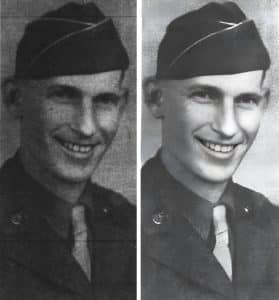
Private Elmer Melvin Peters was born on April 17, 1910, in Belvidere. Both he and his younger brother Robert served in the U.S. Army and were killed in action during World War II.
Elmer was the second child of William and Alvina Peters. He had five brothers and one sister, and the family settled in Crystal Lake when he was eight years old. Elmer and his siblings attended Immanuel Lutheran School and were active in the congregation of Immanuel Lutheran Church, where he also received confirmation.
In June 1939, Elmer married Sibyl Sinkler in a small ceremony at her parents’ home. The couple lived in Elgin, where Elmer worked at Woodruff and Edwards, an iron foundry.
Elmer entered the U.S. Army on October 25, 1943, at the age of 33. His father passed away just one day later. Despite the loss, Elmer continued with his training at Fort Sheridan and Camp Wolters. He was deployed to Europe in May 1944, serving as a rifleman in Company B, First Battalion, 8th Infantry Regiment.
In November 1944, Elmer’s unit reached the Hürtgen Forest as part of the Allies’ push into Germany. The Battle of Hürtgen Forest became one of the longest and most grueling battles fought by American forces in Europe. They encountered dense woods, fierce resistance, and a high number of casualties.
On November 29, while advancing on enemy strong points in the forest, Elmer’s platoon came under heavy mortar and artillery fire. He was wounded by shell fragments and died the following day in France. His brother Robert had been killed a few weeks earlier.
Elmer was initially buried at Henri-Chapelle American Cemetery in Belgium, along with many other U.S. soldiers who died in the region. A memorial service for Elmer and Robert was held in February 1945 at Immanuel Lutheran Church.
On January 10, 1948, Elmer’s and Robert’s remains were returned home to Crystal Lake. Despite the cold, a large crowd gathered on the train platform that morning when their caskets arrived with military escorts. The brothers were reburied in Union Cemetery, following a joint funeral. The American Legion and VFW provided full military rites.
In the years that followed, Elmer’s widow Sibyl remarried a man named Earl Patton and moved to Seattle. Their mother, Alvina, was the only known Crystal Lake mother to lose two sons during the war, but she was grateful for the compassion the community showed her, once saying, “People have been so kind to me that it has made my burden much less difficult to bear.”
Robert F. Peters
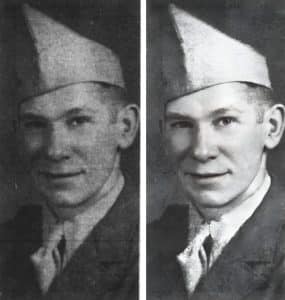
Private First Class Robert F. Peters was born to William and Alvina Peters on April 17, 1923, in Crystal Lake. Known affectionately as “Bob,” he had the same birthday as his older brother Elmer, though they were thirteen years apart. The two shared much in life, including faith, service, and ultimately, sacrifice during World War II.
Robert was the youngest of seven children and grew up in a close-knit family. He and his siblings attended Immanuel Lutheran School and were active in the church, where he joined the choir and the Walther League youth group. He also played violin, enjoyed bowling, and ran track. In 1941, he graduated from Crystal Lake Community High School.
Once he finished school, Robert worked in the shipping department at the Oak Manufacturing Company, which produced electronic parts for radios. His gregarious personality earned him many friends there. When he was drafted in early 1943, Oak Manufacturing and the Walther League threw send-off parties for him and other men leaving for military service.
After being inducted into the U.S. Army in February 1943, Robert trained at Fort Sheridan, Camp Hood, and Camp Maxey. He started with a tank destroyer unit and eventually moved into the infantry. Robert enjoyed his training and wrote home frequently, once noting: “Boy, it’s really swell out here, and can I sleep well. There’s so much fresh air, a fellow hates to get up.”
When Robert was deployed to Europe in August 1944, he served as a member of Company K, 109th Infantry Regiment, 28th Division. A few months later, his platoon fought in the Battle of Hürtgen Forest, which was one of the longest and costliest battles in the war. They faced intense mortar and artillery fire in the dense woods of Germany. Robert was killed in combat on November 2, 1944; he was first reported as missing in action, but officials later confirmed he died that same day. He was 21 years old. His brother Elmer died four weeks later during the same battle.
Like his brother, Robert was initially buried at Henri-Chapelle Cemetery in Belgium. A memorial service was held in their honor in February 1945 at Immanuel Lutheran Church. In January 1948, the brothers’ remains were repatriated home to Crystal Lake at their mother’s request. A double funeral was held, and the American Legion and VFW provided full military honors at Union Cemetery, where they were laid to rest beside each other.
William Chandler Peterson
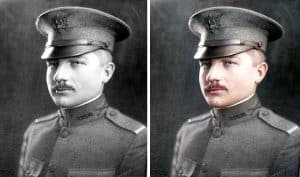
Second Lieutenant William Chandler Peterson, known to his family and friends affectionately as “Chandler,” was a promising young architect who lost his life during World War I. Born on December 24, 1894, in Crystal Lake, he was the third of five children born to Frederick and Emma Peterson.
After graduating from the Union School in 1912, he earned a degree in architecture from the University of Illinois at Urbana (as the school was known) in 1916. Notably, while a sophomore in college, he designed a gymnasium addition for his high school alma mater; he provided his services at no cost. Although the Union School has since been demolished, a terra cotta plaque honoring Chandler now resides in the lobby of Husmann Elementary, which was built on the original site.
His professional career started at the Northwestern Terra Cotta Company and later the Leonard Construction Company in Chicago. He had once intended to further his architecture studies in Paris, but his plan changed when the U.S. entered World War I in 1917.
Answering the call to service, he traded his drafting tools for a rifle and joined the Second Officers’ Training Camp at Fort Sheridan. Once he received his commission as Second Lieutenant, Chandler was deployed to France in January 1918. Initially unassigned, he was soon transferred to the 49th Company, 1st Battalion, 5th Marine Regiment, 2nd Division of the American Expeditionary Forces. By March 12, 1918, he was in the front-line trenches.
In the Battle of Château-Thierry, Chandler led his platoon in a morning assault on June 6, 1918. Part of the larger Aisne-Marne Offensive, the battle was critical to stopping the German push toward Paris. During the attack, Chandler was killed instantly by machine gun fire. He was 23 years old
For his extraordinary heroism in action, Chandler was posthumously awarded the Distinguished Service Cross, the second-highest medal of valor in the U.S. military. Today, his cross is preserved at the Crystal Lake Historical Society.
Chandler’s death was deeply felt in Crystal Lake, and hundreds of people attended his memorial service. In 1919, the newly chartered American Legion Post No. 171 in Crystal Lake was named in his honor. For over a century, the William Chandler Peterson Post has remained an active presence in the community.
In September 1921, Chandler’s remains were repatriated home. A funeral service was held in the gymnasium he designed, followed by a procession to Union Cemetery that included a military band, local and regional American Legion posts, friends, and family. He was laid to rest with full military honors.
As his former teacher, H.A. Dean, reflected, “It was [Chandler’s] nature to keep pouring out the best that was in him to help others.”
Ragnar A.B. Randau
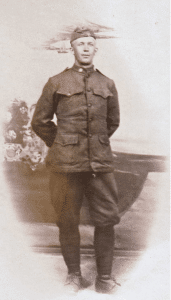
Private Ragnar Anshelm Ingbert Randau was a Swedish-born immigrant who served during World War I and died while stationed in France. Born on July 11, 1888, in Billesholm, Skåne County, Sweden, he moved to Crystal Lake in the spring of 1910 at the age of 21. Fondly known as “Bert,” he lived with his older brother Ernest and worked as a mason.
Crystal Lake had a vibrant Swedish community at the time, known as “Swedenberg,” and Bert quickly embraced his new home. He joined local civic organizations, including the Nunda Lodge No. 169 of the Free and Accepted Masons and the Independent Order of Odd Fellows. Although listed as “Bert Randall” on a charter roster, he likely helped establish the Odd Fellows Lodge No. 451 here in Crystal Lake.
In August 1918, Bert became one of 500 men naturalized at Camp Grant in order to enter military service. He enlisted as a private in Company B of the 311th Engineers, which was part of the Black Hawk Division. As time wore on, his family grew concerned when they didn’t hear from him for many weeks. On October 9, 1918, Bert died from meningitis at the U.S. Army Base Hospital No. 22 in France at the age of 30.
As was unfortunately common at the time, communication delays and conflicting reports caused confusion about his death. A servicemember in his division wrote home and mistakenly attributed Bert’s death to the Spanish flu. When Bert’s brother reached out to the military for more information, they had no record of his death at all. His family didn’t receive final confirmation of the date and cause of his death until December. He was survived by his parents, three brothers, and three sisters.
Bert was initially buried with full military honors in Mérignac, near Bordeaux, France. In January 1919, a large memorial service was held for him at the Methodist Episcopal Church in Crystal Lake. His remains were later returned in November 1920 for burial here. Services were held at J.W. Gilbert’s funeral parlor, followed by a long procession to Union Cemetery, which included the color guard and members of the William Chandler Peterson American Legion Post 171; members of Nunda Lodge No. 169; and members of the Crystal Lake Lodge No. 451. Bert received a full military salute at his grave in Union Cemetery. There is also a tree across the street from Hickory Hall that commemorates his life.
Described as a “manly, ambitious, and honorable young man,” Bert was remembered with respect and affection by many. He left a legacy of service and devotion to both his adopted country and the community he chose to call home.
John M. Rowley
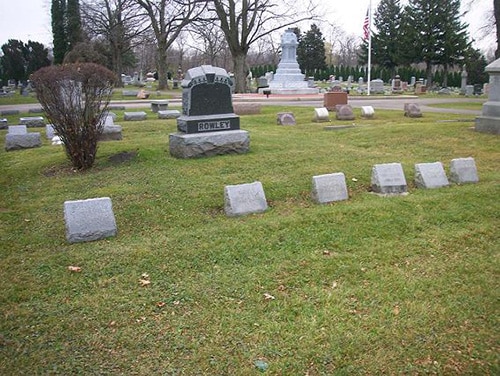 John M. Rowley was born on February 7, 1834, in Addison, New York, to Lucy and Amos Rowley. He was one of ten children. Most of the family moved to Illinois around 1845, presumably to be closer to Lucy’s relatives, who had also moved to the area. Soon, the Rowleys settled down in Nunda, where John worked on the family farm.
John M. Rowley was born on February 7, 1834, in Addison, New York, to Lucy and Amos Rowley. He was one of ten children. Most of the family moved to Illinois around 1845, presumably to be closer to Lucy’s relatives, who had also moved to the area. Soon, the Rowleys settled down in Nunda, where John worked on the family farm.
On May 24, 1861, a little over a month after the Civil War began, John mustered in with the Union Army around 75 miles west in Freeport, Illinois. He served as a private in Company F of the 15th Illinois Infantry Regiment. Unfortunately, disease was rampant among soldiers during the Civil War. In 1862, he fell ill and was granted furlough to return home. John never recovered and died on February 22, 1862, at the age of 28. He was survived by his mother and siblings.
After his death, the 15th Illinois Infantry Regiment went on to fight in many battles and campaigns, including Sherman’s March to the Sea, the Siege of Vicksburg, and the Battle of Shiloh. The regiment endured extreme conditions and marched over 4,000 miles during the war. They mustered out of service in September 1865.
Although John was originally buried at Crystal Lake Cemetery, his brother Charles moved John and other family members to Union Cemetery in 1901. The Rowley family now rests here together.
Gordon B. Schlottman
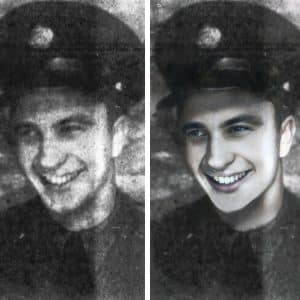
Staff Sergeant Gordon Bernard Schlottman was born in Cary on August 20, 1917, to Matie and Arthur Schlottman. He was the middle child of three, growing up on the family farm alongside his older sister, Gladys, and his younger brother, Glen. Neighbors had fond memories of the Schlottman children leaping from barn rafters into piles of hay with their friends.
Known to his classmates as “Gordie”, he attended Crystal Lake Community High School and was deeply involved in his community. He was a member and the treasurer of the Cary Athletic Club, where he played the role of Revered Boswell in a production of the farce Hillbilly Courtship. He was also active in the local 4-H club. Gordon spent his early working years helping his brother-in-law, Frank Prokop, at the Route 19 Garage in Fox River Grove, and later worked at the Bud Henry Motor Company in Barrington.
In August 1941, Gordon joined the United States Army Air Corps at Fort Sheridan. However, less than a year later, he was killed in a plane crash on September 16, 1942, at the age of 25. He was one of six servicemen aboard a B-26 twin-engine bomber en route from Lakeland, Florida, to Louisville, Kentucky.
As the aircraft approached Birmingham, Alabama, they encountered intense rain, turbulence, and low visibility. When the pilot attempted to lower the plane’s altitude, the bomber struck the wooded slopes of Double Oak Mountain and exploded on impact. The pilot, a recent graduate of flight school, lacked the experience to navigate such “impossible weather conditions,” as later reports described.
Gordon’s funeral was held a week later, and he was buried here in Union Cemetery. Though his life was brief, he left a lasting impression on his community, friends, and family as a friendly and engaging young man.
LaVerne T. Schroeder
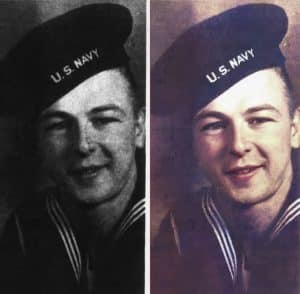
Seaman Second Class LaVerne Timm Schroeder was an energetic and hardworking young man who died of illness not long after entering service during World War II. Born on July 23, 1925, to Edward and Wilhelmine “Minnie” Schroeder, LaVerne was the youngest of six children.
His early life was marked by both joy and loss. Three of his siblings died young, but he grew up with his sister Bernice and brother Glenn in a house on McHenry Avenue. While in grade school, he performed the role of the “Strong Man” in a whimsical operetta called The Celestial Circus, displaying his playful spirit even then.
LaVerne attended Crystal Lake Community High School and was a standout athlete. He played football, baseball, basketball, and tennis; his achievements were frequently mentioned in the Crystal Lake Herald. He was also a percussionist in the school band and worked for Scott C. Colby at Colby Motor Sales.
Though still in high school, LaVerne enlisted in the U.S. Navy on his 18th birthday in July 1943. He mustered a few months later and attended boot camp in Farragut, Idaho. The local road committee requested a deferral because Crystal Lake needed LaVerne to drive a snowplow that winter, but he was already on his way to serve.
LaVerne was stationed at the Naval Training School at Miami University in Oxford, Ohio, where he began his technical radio training. Though reportedly in good spirits just a few weeks earlier, he suddenly suffered a bout of acute appendicitis. Following an emergency appendectomy, he died of peritonitis on February 29, 1944—nearly four months after starting his military service.
He was laid to rest in Union Cemetery in early March of that year. His brother Glenn served in and survived the war but died in January 1946 after a short illness. In 1949, Edward, Minnie, and Bernice published the following poem in remembrance of both LaVerne and Glenn:
Do not ask if we miss them,
There is such a vacant place.
Oft we think we hear their footsteps,
And see their smiling face[s].
Days of sadness still come o’er us,
Tears and silence often flow.
Memories keep them ever near us,
Though they left us three and five years ago.
The entire Schroeder family is buried here together in Union Cemetery.
Clayton B. Starritt

Private First Class Clayton Bruce Starritt was born on October 28, 1913, in Crystal Lake, the eldest child of Clyde and Ella Starritt. He served with distinction in the U.S. Army during World War II, earning the Bronze Star and an oak leaf cluster for exceptionally meritorious achievements in France and Germany.
Clayton grew up on the family farm with his younger siblings, Kenneth and Irene “Kitty” Starritt. He attended the one-room Terra Cotta School, where he earned recognition on the honor roll, and later graduated from Crystal Lake Community High School with the Class of 1932.
He distinguished himself in high school with a strong work ethic, maintaining perfect attendance throughout multiple semesters, and he competed in track and field, winning a shot put event during his senior year. Clayton was well-liked by friends and classmates and had a dry sense of humor. When asked about New Year’s resolutions by the Crystal Lake Herald in 1931, he noted that he made none, as it went against his principles to prevaricate.
Clayton went on to work for the American Terra Cotta Company, known for its production of architectural terra cotta, fireproof building materials, and the popular Teco Pottery line. This period in his life was marked by both loss and joy: In 1936, his father passed away following an operation, and in 1941, he celebrated his sister Kitty’s wedding with family and friends.
On February 15, 1943, Clayton entered the U.S. Army. After completing training at Camp Wolters and Fort Meade, he spent a final Christmas furlough with his family. On Christmas morning, he headed for the East Coast before sailing overseas to serve in the 38th Infantry Regiment across Europe.
Clayton was wounded in the right arm during the early stages of the Battle of Brest in June 1944. Once he recovered at a hospital in England, he rejoined his company in early August and saw increasingly heavy fighting as Allied forces pressed toward Germany.
In December 1944, during a brief reprieve in Aachen, Germany, he sent his mother a Christmas card. This was the last time she would hear from him.
Clayton was killed in action on December 20, 1944, during the Battle of the Bulge in Krinkelt, Belgium. This battle was Germany’s final major offensive on the Western Front, intending to split Allied forces and capture Antwerp. Although the U.S. suffered massive casualties, the sustained Allied defense was critical in stopping the German advance and giving the Allies the momentum to eventually win the war. His regiment’s valor during this battle earned the 38th Infantry Regiment a Presidential Unit Citation for extraordinary heroism.
Clayton’s remains were initially interred at Neuville-en-Condroz, Belgium, but were later returned to Crystal Lake in 1949. He was buried with full military honors at Union Cemetery. Today, he rests here with his entire family.
Ralph P. Wells

Born on June 11, 1899, in Chicago, Private Ralph Parks Wells grew up in a close-knit family of eight and carried a deep appreciation for home and the world around him.
When Ralph was six, his parents, Peter and Mary Wells, moved the family to Woodstock. He helped his father on the family farm and graduated from the Silliman School in 1912. He also briefly worked at the Oliver Typewriter Factory. At 18, Ralph enlisted in the U.S. Army during World War I and joined Company E of the 7th Regiment Engineers.
His service took him from Jefferson Barracks to Fort Leavenworth, then to France in March 1918. Though he didn’t see direct combat, he worked long hours with his unit, likely building bridges. Even after recovering from the measles and facing the strain of military life, Ralph remained in good spirits and kept in touch with his parents and siblings. “When a letter comes,” he wrote, “I never look to see who it is from; the fact that it is from home is enough for me.”
While abroad, Ralph marveled at the bridges over the Seine and the royal palaces near Paris. In his last letter, he wrote, “I wish you could be here with me, Father, as I know how you would enjoy it. If I ever get out of this game alive I’ll bring you over to this place.” Sadly, this was never to be. Ralph passed away less than two weeks later on May 19, presumably while performing his duties as an engineer. He was the first man from Woodstock to lose his life in World War I.
There was a lot of initial confusion over his death. At first, it was believed he died on board the HMS Moldavia when a German U-boat torpedoed it on May 23. The oversight likely occurred because the ship was transporting American soldiers from Britain, and Ralph had recently returned from a hospital stay in England to recover from the measles.
Over two years later, his body was returned home and laid to rest on October 30, 1920. His funeral, held at the First Methodist Episcopal Church, was attended by over forty American Legion members. To honor Ralph and seven other fallen employees, the Oliver Typewriter Factory installed a memorial in their building with a bronze plaque, an American eagle statue, and photographs of each serviceman.
After Ralph’s death, his parents went on to have three more children. Today, Ralph lies beside his parents and two of his brothers in Union Cemetery. Though his life was brief, he is remembered not only for his sacrifice but for the warmth and deep affection he held for his family until the very end.
